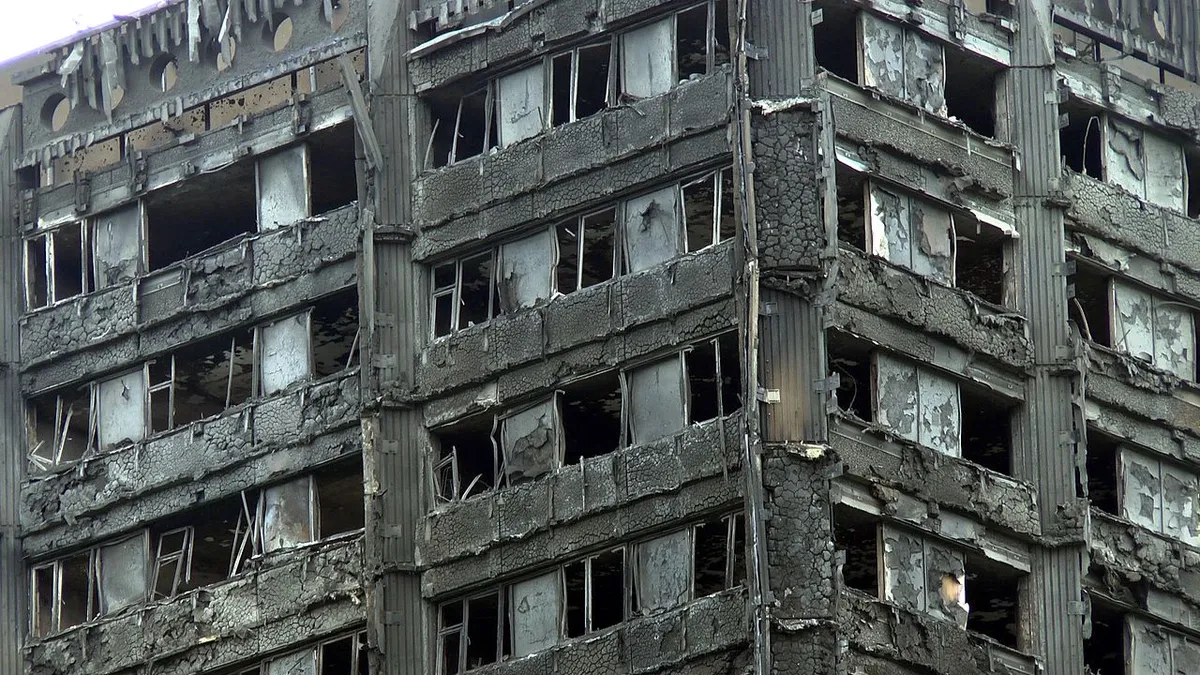Dive Brief:
- Officials in the United Kingdom have concluded the first phase of their investigation into the fatal June 2017 Grenfell Tower fire in London and have determined that the reason the blaze was able to spread so quickly was that the building's cladding — aluminum composite material (ACM) rainscreen panels — acted as "fuel" for a fire that began in one of the unit's kitchens. The fire killed 72 people.
- Once the fire hit the cladding, most likely through a gap created by a heat-damaged window jamb, it was able to cover the entire building in fewer than three hours, helped along by polyisocyanurate (PIR) and phenolic foam insulation boards behind the cladding and exposed polyethylene in a decorative crown. Smoke and fire were able to spread through the interior via windows, exterior kitchen fan units and the failure of fire doors, some of which did not have self-closing mechanisms.
- Investigators found "compelling evidence" that the external walls of the tower did not meet building code fire-resistance requirements. Official recommendations from the report for practices going forward include that information, including plans, about a building's materials and construction methods be made available to fire and rescue services.
Dive Insight:
During the inquiry's second phase, officials will look at:
- The decision to use a highly combustible cladding system on a high-rise residential building
- The current protocols for testing the combustibility of materials and cladding systems
- The reliability of material certifications
- The adequacy of fire safety regulations for high-rise buildings
- Why some fire doors failed
- Window design using uPVC (unplasticised polyvinyl chloride) close to combustible materials
- Possible new requirements for elevators designated for use by fire and rescue teams
- Whether the building's smoke extraction system operated as intended
These questions and others raised in the inquiry serve as a reminder, according to attorney Judah Lifschitz, partner and co-president of Shapiro, Lifschitz and Schram PC in Washington, D.C., that even those who design and build these structures always are in learning and discovery mode.
"I think the average person — the layman — thinks that design and engineering are black and white and perfect," he said, "and then it takes small and large tragedies or failure to realize that, at the end of the day, we're still dealing with people. And, therefore, people make mistakes...in design, or there are still things we don't know or our experience hasn't taught us."
Unfortunately, Lifschitz said, the combination of materials and cladding allowed the fire to spread. "That's the result of human failure."
Here in the U.S., he said, from a fire-safety point of view, there are multiple layers of requirements to either avoid a fire in the first place or recognize that fires happen and include design and equipment that will contain them, such as fire-rated materials, fire dampers, fire doors, firesafing, fireproofing.
However, the human factor means that things could go wrong, conjuring up the inevitable lawsuits.
Survivors and victims' families have filed suit in the U.S. against U.S.-based manufacturers of the cladding and foam insulation used in the Grenfell Tower's renovation — Arconic Inc. and Celotex, respectively — alleging that the products stoked the deadly fire and even released cyanide gas that killed some residents.
"If this were to happen here," he said, "[the likely defendants] would be virtually anybody involved in design and construction." This includes architects, engineers, contractors, subcontractors, manufacturers of the cladding and of other building materials, along with all of those parties' insurers.
The second phase of the investigation is set to begin in early 2020, and officials will release another report once that process is finished.












